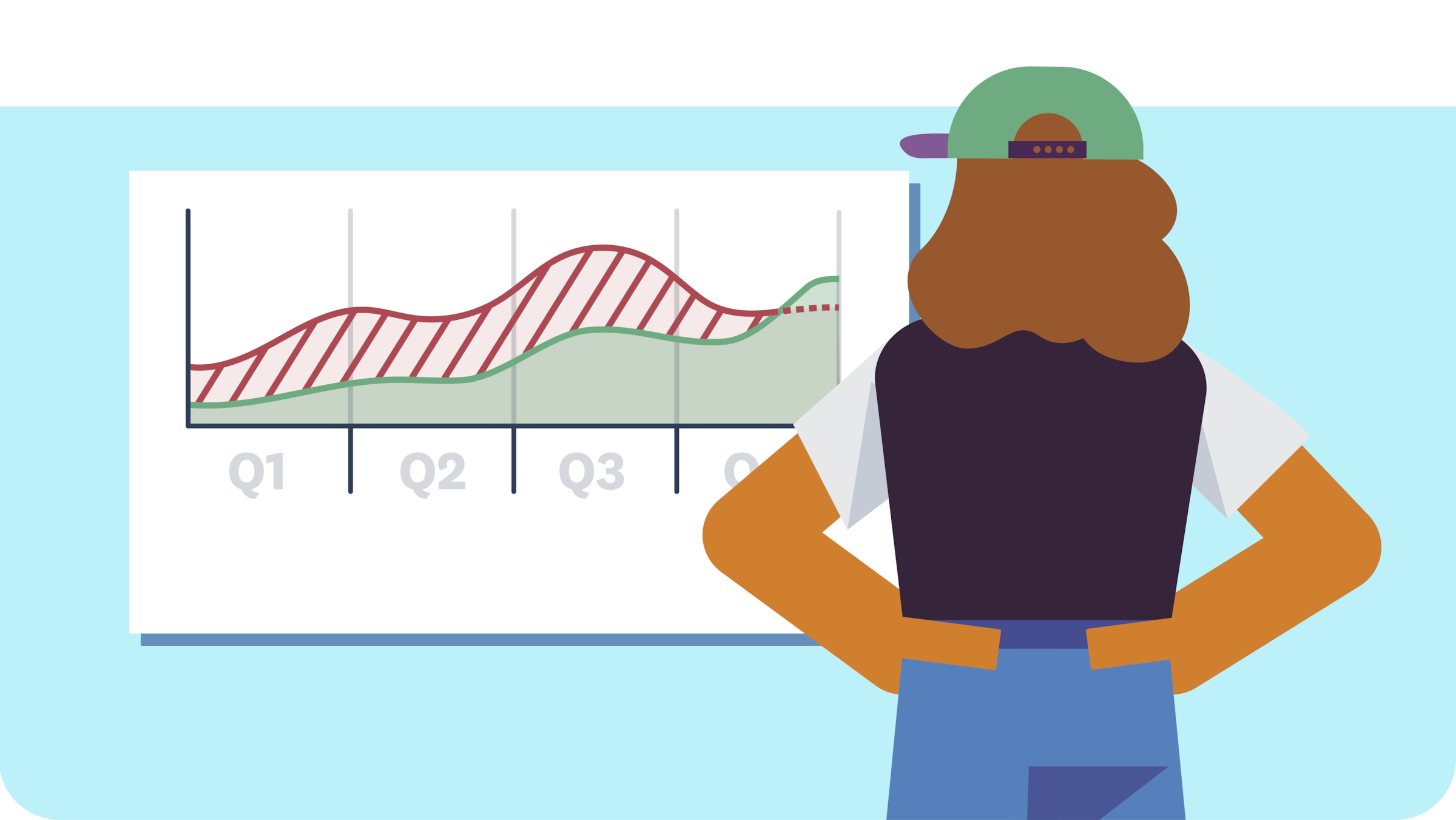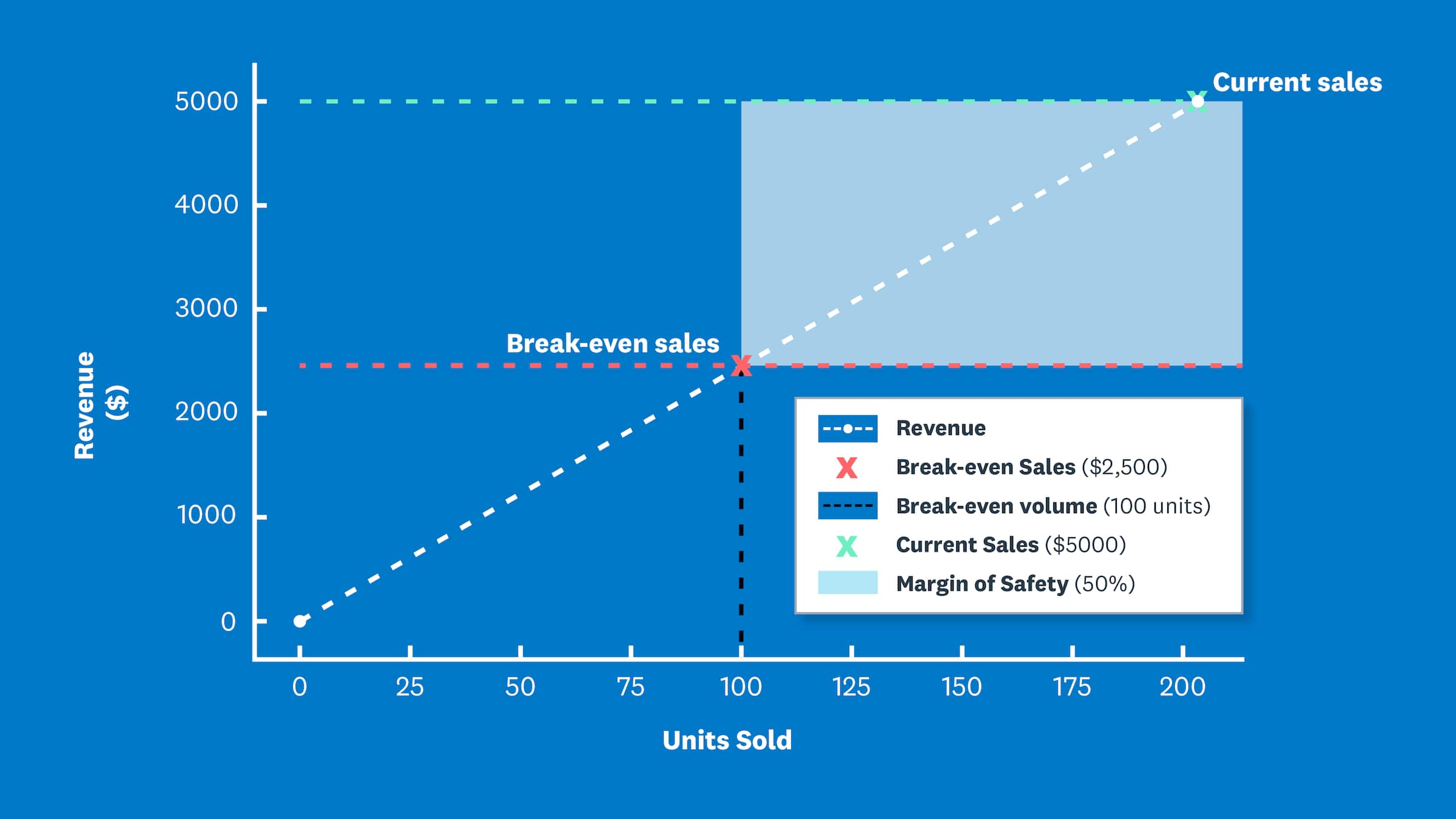Margin of safety: definition & how to calculate it
Learn what the margin of safety is, how to calculate it, and why it matters for making better financial decisions.

Written by Shaun Quarton—Accounting & Finance Content Writer and Growth Marketer. Read Shaun's full bio
Published Tuesday 6th May 2025
What is the margin of safety?
The margin of safety is a measure of the financial risk to your business – it shows you how far your sales can fall before they reach your break-even point – where revenue equals costs and the business makes neither a profit nor loss.
Your margin of safety is your financial buffer against drops in demand or cost increases – the wider this margin is, the better!
What is the margin of safety formula?
You can calculate the margin of safety using this straightforward formula:
(Current sales - break-even sales) / current sales = Margin of safety
- Your current sales figure is your business’s total revenue (from selling goods and services) over a specific period.
- Your break-even sales number is the exact amount of revenue needed to cover all fixed and variable costs. It’s the point where your business makes zero profit and a zero loss.
Here’s a quick margin of safety example.
Let’s say a business has current sales of $50,000 and needs $30,000 in sales to break even.
Margin of safety = ($50,000 – $30,000) / $50,000 = 0.4 (40%)
This means the business’s sales could drop by 40% before it hits its break-even point. Any further sales drop would result in a loss.
The margin of safety calculation is set out in more detail below.
The importance of the margin of safety for your small business
The margin of safety is essential to your risk management strategy. It shows how far sales can fall before your business starts making a loss.
- If you have a high safety margin, your risk is low – your business can absorb small shifts without much disruption.
- With a low safety margin, you’re at higher risk – you’re operating close to your break-even point with less room to manoeuvre.
Consider how an external shock (like a jump in supplier prices) would affect your business. This increase in variable costs pushes up your break-even point, eating into your margin of safety and leaving your business exposed to further cost increases or falling sales.
Your margin of safety also supports smarter financial decisions across your business. See the section below on how the margin of safety supports your small business decisions.
How to calculate margin of safety
Now let’s break down the margin of safety calculation.
1. Find your current sales
The first step is to determine your current sales – whether they’re actual or forecasted.
Your current sales figures should be readily available and easy to find through your existing sales tools.
But forecasting your sales can take a bit of analysis and some educated guesswork. Here are four common avenues to start with:
- Historical data – Analyze your financial reports for past sales trends and seasonal patterns. You’ll find these on your POS system, eCommerce platform, or accounting software like Xero.
- Market research – Study your target market, industry trends, and competitor performance.
- Qualitative forecasting – Ask your sales team or industry experts for their insights.
- Quantitative forecasting – Use statistical methods to analyze your historical and market data to predict future sales more accurately.
The best approach for you depends on your business type and the data available to you. For example, a craft business uses a POS system to track monthly sales. Last month, sales were $5,000. This figure is used in future steps of the margin of safety calculation.
2: Calculate your break-even sales revenue point
Usually, the break-even sales point is the number of units you need to sell to cover all your costs.
But for the margin of safety calculation, you’ll need a sales revenue figure instead. Here’s the formula:
Fixed costs ÷ ((Sales price – Variable cost) ÷ Sales price) = Break-even sales
In the formula:
- Fixed costs are expenses that stay the same, regardless of sales volume – like salaries and rent.
- Variable costs change with sales volume – such as raw materials and sales commission.
Here’s more info on variable costs and how they differ from fixed costs. Your accountant can also help you distinguish between them.
To demonstrate, let’s say the craft business has:
- Fixed costs of $2,000
- Variable costs of $5 per unit
- A sales price of $25 per unit
Therefore:
2,000 ÷ ((25 – 5) ÷ 25) = Break-even sales revenue = 2,000 ÷ (20 ÷ 25) = 2,000 ÷ 0.8 = $2,500
So with a sales price of $25, you need revenue of $2500 (100 sales units) to break even.
Learn more about your break-even point.

3: Apply the margin of safety formula
Finally, apply the margin of safety formula:
(Current sales – Break-even sales) ÷ Current sales = Margin of safety
The result is your margin of safety ratio – the percentage by which sales can fall before your business starts operating at a loss.
Let’s apply the formula to the craft business example, where current sales are $5,000 and the break-even point for sales revenue is $2,500:
($5,000 – $2,500) ÷ $5,000 = Margin of safety = 2,500 ÷ 5,000 = 0.5 = 50%
The craft business has a 50% margin of safety, meaning sales could fall by half before they reach the break-even point.
How the margin of safety supports your business decisions
Your margin of safety helps you make fundamental decisions in key areas of your small business:
- Setting performance targets – by calculating a clear break-even point, you can set clear, achievable sales targets to stay profitable
- Setting prices – if your margin of safety is shrinking, check your pricing so each sale contributes enough to cover costs
- Controlling costs – a low margin of safety can signal the need to cut costs and protect your buffer
- Evaluating new products or services – before launching something new, see how the costs of your proposed new product affect your margin of safety and your ability to turn a profit
Other metrics work with the margin of safety in your accounting analysis
The margin of safety is most effective as an input into your business decisions when used with other key financial metrics.
The margin of safety also supports other analytical techniques. For example, when used with CVP analysis, your margin of safety helps guide your planning because together they give you a clearer view of your profitability and risk than you could get from your margin of safety alone.
Margin of safety and CVP analysis
The margin of safety is an output of cost-volume-profit (CVP) analysis. While margin of safety highlights the financial buffer you have today, CVP is a forward-looking exercise. It models different scenarios related to your cost structure, sales volume, and pricing to help you understand how they affect your business’s profitability. It shows how adjusting any one of these factors – up or down – affects your bottom line.
Used together, CVP analysis and margin of safety guides your planning by giving you a clearer view of both profitability and risk.
Learn more about decision-making
Master your margin of safety with Xero
Calculating your margin of safety can be time-consuming. You need to track down the right figures, update spreadsheets, and manually piece together reports.
Xero takes the manual labor out of calculating your margin of safety. No more scouring reports and updating spreadsheets – Xero gives you quick access to the financial data and reports you need to work out your margin of safety faster and make informed decisions with confidence.
Disclaimer
Xero does not provide accounting, tax, business or legal advice. This guide has been provided for information purposes only. You should consult your own professional advisors for advice directly relating to your business or before taking action in relation to any of the content provided.
Get one month free
Sign up to any Xero plan, and we will give you the first month free.